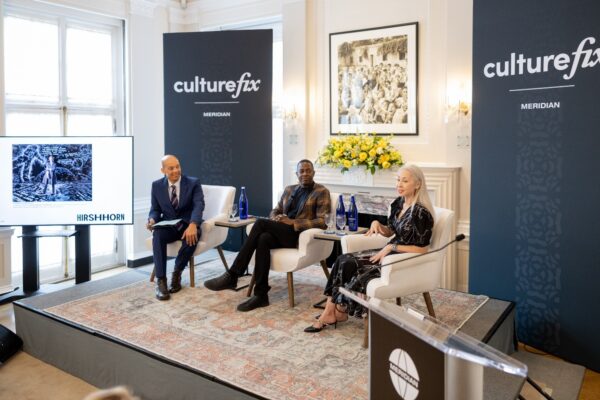Mirror and Messenger: How Art Constructs Shared Meaning

On June 5, 2025, Meridian International Center hosted interdisciplinary artist Sanford Biggers and Melissa Chiu, director of the Smithsonian’s Hirshhorn Museum and Sculpture Garden, for Mirror and Messenger: How Art Constructs Shared Meaning. As part of the 5th annual Culturefix morning conversations, this discussion, moderated by co-anchor and co-managing editor of the PBS NewsHour Geoff Bennett, explored how contemporary art serves as a powerful tool for storytelling, cultural diplomacy, and social connection—challenging historical narratives, expanding identity, and reimagining the role of both artists and museums in a global context.
Here are some top takeaways from the program:
1. Art as a Tool for Civic Engagement and Cultural Diplomacy
Contemporary art is a bridge between cultures, communities, and public discourse. Melissa Chiu reflected on the Hirshhorn’s location on the National Mall, noting how its proximity to other national institutions creates a layered conversation about what Americans see—and what narratives are uplifted. She reinforced this by describing museum work as diplomatic actors in their own right, using examples like artist exchanges, exhibition curation, and public programs to build empathy and understanding. Sanford Biggers shared his experiences from international residencies such as the Akademie Schloss Solitude in Germany, emphasizing how artists can act as informal cultural diplomats in unexpected ways—bringing people together not just in galleries but through lived interactions and shared experiences.
2. Artists Shape—and Disrupt—the Narrative
There is an ethical and social responsibility of artists to provoke thought and push boundaries. Bennett prompted how visual artists can take responsibility for shaping public narratives and uplifting marginalized voices. Chiu emphasized that museums should help audiences see the artist as a person first—someone whose work carries meaning beyond aesthetics. Biggers added that art inherently carries political weight, whether intentional or not, and can spark important conversations. Both panelists agreed that artists play a key role in reflecting society back to itself while also imagining new possibilities.
3. American Identity is Not Static—and Neither is Art
Contemporary art disrupts narrow or monolithic ideas of national identity. Bennett questioned how artists can use visual language to expand our understanding of what it means to be American. Chiu shared stories of artists such as Gustavo and Otavio Pandolfo, known globally as OSGEMEOS and collaborations with global figures like Banksy, showing how cross-border relationships can reshape cultural narratives. Biggers spoke about his own layered identity as a former graffiti artist and how his work tells multiple stories at once. Together, they suggested that American identity—like art—is constantly evolving, enriched by diverse voices and global exchange.
4. Reconnecting with Craft and “Slow Art” in the Digital Age
In contrast to the fast-paced digital world, artists are returning to the handmade. Bennett advocated for a renewed appreciation of slow, tactile art forms, particularly in response to the rise of AI-generated art. Chiu echoed this, noting a resurgence in clay, tapestry, and other traditional crafts as a grounding force in contemporary practice. Sanford Biggers added that time itself is a material in artmaking, where the process and texture matter as much as the message. This revival of craft is not nostalgic but rather a meaningful way to reconnect with intention, labor, and humanity in the age of automation.
5. Museums Must Evolve into Living, Responsive Spaces
The role of cultural institutions has evolved from passive repositories to platforms that facilitate timely dialogue. Melissa Chiu described how programming—such as live talks, performances, and interactive guides—can activate exhibitions and deepen audience engagement. Chiu spoke candidly about the challenge large institutions face in staying outward-focused, and challenged institutions to incorporate historical context and artist voices into the museum experience. Bennett questioned what it truly means to create engagement in a museum setting, while Biggers emphasized that artworks gain new meaning through the people who interact with them. In this, art and the spaces that house art are living forces. Museums that embrace dialogue, storytelling, and community connection will be the ones that remain relevant in an era of rapid change.
Project summary
| Mirror and Messenger: How Art Constructs Shared Meaning | June 2025 | |
|---|---|
| Countries: | United States |
| Impact Areas: | Sports and Cultural Diplomacy |
| Program Areas: | Sports and Culture |